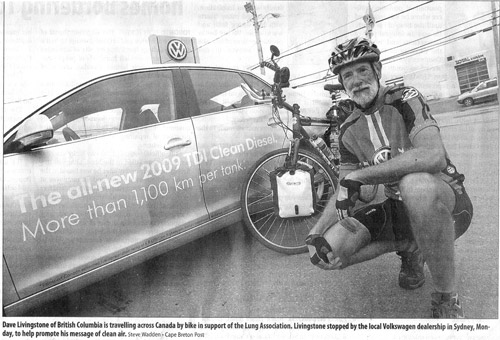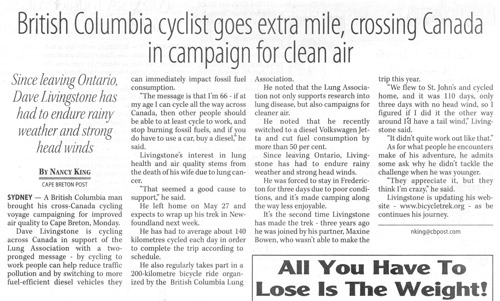Have you cycled in the open during a thunderstorm, and wondered how to avoid being struck by lightning?
The most common advice is to “remain in your car with each window closed”! Useless advice for cyclists! We asked an expert, Dr William Burrows, PhD Research Scientist at the Physics and Severe Weather Research Section – Downsview, Ontario. Following the photo below, is his expert advice:
Prairie Lightning photo courtesy Andrea Schneider at Prairie Angels Co.
Cycling safety during a thunderstorm.
Essentially you have to be sure you are not the highest object around when a thunderstorm is overhead. You are likely safe in the situation where you are between narrow high walls of rock – but beware when you are in a wide open area such as the Canadian Prairies. The best idea is to be inside an object such as a building (maybe find a barn or other farm building). It will act like a Farraday cage, where the electrical charge can flow around the outside to ground – be sure you do not touch the sides. If you are in the open and there is nowhere to hide then you should get as low as possible by crouching in the ditch until the storm passes. It would also be wise to remain a few feet away from your bike when in the ditch in case it is struck and the lightning jumps over to you. Do not stand under or near a tree – many people have been injured or killed when lightning strikes them by jumping out of the side of the tree, or when it runs a short distance from the tree through the ground and strikes them on the soles of their feet. Bicycle tires are not going to help you much if lightning strikes you because they are too small and thin to insulate you against the massive electrical charge in a lightning bolt. To judge when you are in danger remember the 30-30 rule. Take precautions if there is less than 30 seconds between seeing the flash and hearing thunder, and wait for 30 minutes after you see the last lightning. The reason for the 30 minute wait is there can be very strong lightning flashes out of the cirrus cloud anvil at the top of the storm. The anvil spreads out a long way from the central core of the storm, so you need to be sure it is not overhead.
Version français.
Sûreté de recyclage pendant un orage.
Avez-vous fait un cycle dans l’ouvert pendant un orage, et vous êtes-vous demandé comment éviter d’être heurté par la foudre ? Le conseil le plus commun est “restent dans votre voiture avec les fenêtres fermées”! Conseil inutile pour des cyclistes ! Nous avons demandé à un expert, Dr. William Burrows, scientifique de recherches de PhD à la physique des nuages et à la section de recherches de temps grave – Downsview, Ontario.
Essentiellement vous avez pour être sûr que vous n’êtes pas l’objet le plus élevé autour de quand un orage est aérien. Vous êtes probablement coffre-fort dans la situation où vous êtes entre de hauts murs étroits de roche – mais prenez garde quand vous êtes dans un secteur grand ouvert tel que les prairies de Canadaian. La meilleure idée est d’être à l’intérieur d’un objet tel qu’un bâtiment (trouvez peut-être une grange ou tout autre bâtiment de ferme). Elle agira comme un camp de Farraday, où la charge électrique peut couler autour de l’extérieur à la terre – soit sûr que vous ne touchez pas les côtés. Si vous devez dans l’ouvert et il y avez nulle part pour cacher alors de vous devrait devenir aussi bas comme possible par l’acroupissement dans le fossé jusqu’à ce que l’orage passe. Gardez-vous vont à vélo plusieurs mètres à partir de vous. Ne vous tenez pas de dessous ou ne vous approchez pas d’un arbre – beaucoup de personnes ont été blessées ou tuées quand des grèves surprise ils en sautant du côté de l’arbre, ou quand il court une distance courte de l’arbre par la terre et les heurte sur les semelles de leurs pieds. Les pneus de bicyclette ne vont pas vous aider beaucoup si des grèves surprise vous parce qu’ils sont trop petits et minces pour vous isoler contre la charge électrique massive dans un boulon de foudre. Pour juger quand vous êtes en danger rappelez-vous la règle 30-30. Prenez les précautions s’il y a moins de 30 secondes entre voir le flash et entendre le tonnerre, et l’attente 30 minutes après vous voient la dernière foudre. La raison des 30 l’attente que minute est là peut être les flashes très forts de foudre hors de l’enclume de cirrus au dessus de l’orage. L’enclume étend loin du noyau central de l’orage, ainsi vous devez être sûr qu’il n’est pas aérien.
To post a comment, click “Comments” below and enter your text, and then in the windows type your name, email and website(if you have one) and then click the “Post (unverified)” button. We look forward to hearing from you.


